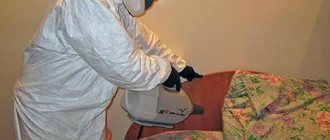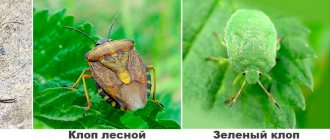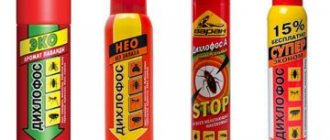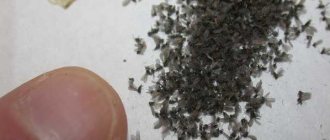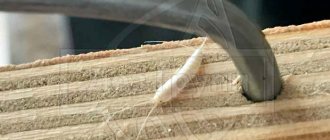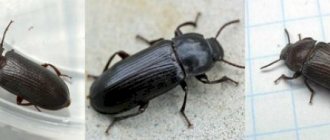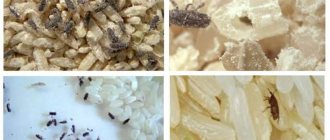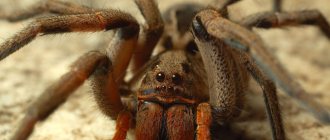The first association with the word “bug” is a nasty smell in the house, bite marks on the body, brown spots on the sheet. But there are many more types of bedbugs, and a significant group of them are united under one name - forest bugs. But most often this is the name given to the green tree shield.
The difference between a forest bug and its domestic relative
It’s not just domestic bugs that settle in the house; their favorite place is the bed or furniture.
Forest relatives suddenly fly into the room. While bed parasites eat human blood, forest dwellers have different food preferences and habitats. In general, you rarely see forest guests in a person’s home; only extraordinary circumstances can drive him there, but this happens, so the home owner should know what this insect looks like.
The content of the article:
|
Ways bedbugs enter the house
Parasites appear in human habitation for various reasons. If they do not have enough food (the neighbors have too many insects) or places to hide, then the bugs will look for a new object. Sometimes they appear by chance.
Anna, 39 years old, Rostov-on-Don
“There had never been bedbugs in the house before until new neighbors moved into the apartment next door. I think insects crawled over from them, because I once came by as a neighbor, and there was such a specific pungent smell. After that, I immediately covered the ventilation grille with a mesh, inspected all the walls, baseboards and sealed the cracks. After treating the apartment, bedbugs no longer appeared.”
Bed bug on the fabric surface of the sofa
Neighbours
If measures are not taken, insects will constantly crawl from nearby apartments, including bedbugs. This is inevitable, since parasites multiply quickly and need additional food sources. The new generation grows up in 2 weeks under normal conditions.
New things
Bedbugs can live on objects for various purposes, not only in apartments/houses. This explains their appearance among purchased new things. The reason is a violation of sanitary standards at the facility where clothes, equipment, and furniture are stored. The bedbugs will be here as long as there is food.
Bedbugs can also appear on new things.Furniture
When buying an old sofa, bed, or wardrobe, bed parasites may appear. The source is sometimes the belongings of relatives that are accepted as gifts. You need to carefully check the internal surfaces
Pay attention to the back walls and shelves. Inspect the internal structure of the sofa, its upholstery
Bedbugs inside an old sofa
Cloth
If things are stored for a long time, are not sorted or used, and bedbugs have entered the room, then over time these insects will also infest closets and chests of drawers with old clothes. If sold and not inspected very carefully, such things will become a source of bedbugs.
Devices
When parasites are discovered in a new object, the likelihood of nests forming inside furniture and equipment increases. After they occupy the sofa and bed (where a person sleeps), they will move to neighboring areas in search of shelter. A TV, refrigerator, printer, computer, air conditioner - any appliance (if it has been idle for a long time) can become a habitat for insects.
Thanks to their narrow body, bedbugs can hide well
Poultry
Bed parasites attack other animals, birds: cats, dogs, rats, chickens, etc. But parasites consider only humans as their main source of food. The properties of its skin and blood are most suitable for these insects. Alternative food sources are other warm-blooded creatures. But it is more difficult to notice that a chicken coop is infested with bedbugs, so the consequences may be worse (diseases, inflammation of puncture sites in the outer integument of the bird).
Moving to a new place of residence
Secondary housing and new buildings - both objects can be infected with the same probability. In the first case, bedbugs are often already in the room when purchased (they crawled from neighbors or got there by accident). In a new apartment, parasites appear along with the owners’ belongings.
Hidden bedbugs in the seams of an old sofa
Forest bug: photo
If a person has not encountered such an insect as the forest bug, the photo of which is presented below, he should become familiar with this population of the natural world.
This is what an insect looks like in the spring. Notice how bright green the bug is.
But for comparison, here is a photo of a bug living under the cover of a sofa. The difference is visible to the naked eye. Unremarkable color, brown. It is he who is full, and if he is hungry, his shade is lighter. Why is that? Everything is related to the habitat in which they live. This camouflage is protection from enemies.
Danger of bites and damage from insects
Most of the described representatives are harmless to humans. They can coexist next to a person in safety, but at the slightest danger, insects begin to emit a specific smell that will be noticeable in the apartment.
As for bites, even if the oral apparatus provides for such a possibility, it will not bring any harm to a person.
The only exception is the predator, which can be a carrier of dangerous diseases and parasites. However, this species is not found in Eurasia. The main damage insects of these subfamilies cause to vegetation, namely, cultivated plants, shrubs, and trees. Moreover, not only the leaves suffer, but also the trunk and fruits. For this reason, you should get rid of insects as quickly as possible, using various measures: spraying, physical removal from the site (individuals are collected in colonies in places of accumulation and taken outside the territory).
Places of residence
The forest bug lives on bushes and trees, while the domestic bug lives in the apartment. The leaves are green in the spring and the bug is all shades of emerald green. As autumn approaches, the color changes and turns purple, the very definition of autumn. For the winter it hides under leaves or under the bark of trees, wakes up in the spring and continues its life activity.
Domestic individuals live indoors, and to make them difficult to detect, they camouflage themselves to match the color of their surroundings.
Habitat
Garden bugs have chosen as their habitat areas where various crops are planted, orchards with fruit trees, and forests. Garden bugs are widespread and varieties can be found on every continent except Antarctica.
What does it eat?
The diet of the garden bug is the green part of cultivated plants, fruits and foliage of fruit trees, as well as cereal crops.
Signs of appearance
Regular inspection of plants will help you notice the presence of harmful bugs in the area in a timely manner. At an early stage, you can notice the larvae, which are localized on the back of the leaves. If the lesion is already beginning to gain momentum, then small holes can be seen on the leaves of trees, shrubs and garden plants.
Flower bugs are widespread in Russia, in the countries of Europe and Central Asia, as well as throughout the world. They live in grasses, shrubs, trees, and forest floors. Some species use bark beetle tunnels. Predators can often be found in grain warehouses and other places where their potential prey lives. They overwinter under fallen leaves, in tree bark, and in animal burrows.
What does it eat?
For example, Antokoris oakgrass feeds on the nectar of female willow inflorescences from early spring, as well as the wintering stages of small herbivorous insects. In summer, the predator extracts nectar from flowering grasses, feeds on the secretions of aphids, and continues to destroy insect larvae and eggs. Antokoris is very voracious and, according to research, is capable of destroying up to 95% of wintering eggs of fruit mites.
During the attack, the predatory bug pierces the body of the victim with its proboscis and injects digestive juices into it. After the insides of the insect are digested, the bug sucks them out using the same proboscis. Tiny predators feed once every 5-10 days, larvae more often - every 3 days. If necessary, they can go without food for much longer and even go into suspended animation. During dry and hot periods, bedbugs feed more often, realizing an increased need for water.
Insect body
The forest bug differs from the bed bug in size, which is quite impressive. If the size of domestic insects is negligible and does not reach one centimeter: 0.5 mm - 0.8 mm, then the forest “native” grows up to 3.5 cm.
The body shape is oval and equally flattened. Domestic parasites have a segmented body.
In the back of the back, the photo shows how the joints are highlighted at the junctions of the segments. The role of the segments is trivial - when saturated, the bug increases in size, and in order not to burst from excessive gluttony, the body is divided into sections. Wild relatives are notable for their bright chitinous coverings, through which the population is protected from attacks by predators.
Learning to recognize bedbugs in your area
As soon as it is not popularly called - stink bug, currant bug, stink bug, garden bug. All these are the names of one family of bedbugs, numbering about 4000 species.
- If your plants are parasitized by green individuals approximately 1-1.5 cm long, this means that this is the most common tree stink bug. It received this name because it has a kind of “shield” on its back. The bug feeds on almost everything that surrounds it - it can be trees, garden crops, and even the remains of other insects. Often, it can be found among green raspberry leaves, cereals, fruits and vegetables, and young tree shoots.
- The marbled bug is a type of stink bug that lives in southern Russia, Abkhazia and Georgia. It has a brown color, with small dots, hence its name. Causes enormous damage to citrus fruits, apricots, persimmons, grapes and other fruit trees. It also feeds on corn, tomatoes, and peppers.
- The berry stink bug can be identified by its brighter color - it has a “berry” tint, thanks to which it is well camouflaged in the bites of currants, chokeberries, raspberries, strawberries, sea buckthorn, gooseberries and other berries.
- A harmful turtle is a bug that looks like a small turtle, with a characteristic pattern and shape of the shell. It has a gray-brown color and mainly feeds on cereal plants. When his diet is poor, he eats everything, causing great damage to the country's agriculture.
- Also well-known soldier bugs, red in color, with black dots in the form of a pattern, love to create colonies and feed on the sap of almost any plant.
- The cruciferous bug is almost identical to the soldier bug, it has a red cover, with an intricate pattern, and a large black dot on the back. It feeds on lettuce leaves, cabbage, radishes, turnips, and celery. Plants practically do not recover after it.
- There are also other common species - for example, the cucumber bug. If you find beds of cucumbers with wilted, eaten leaves, it means that they liked the cucumbers, and the cucumbers need proper processing.
Why are forest dwellers called stinkers?
Household insects can only be detected by smell by people with a keen sense of smell, while the green forest bug smells disgusting. The amber of home inhabitants is subtle and similar to the smell of almonds or raspberries.
If you crush a forest dweller or inadvertently bite into a raspberry, which the predator adores, then you will not be able to escape the unpleasant taste in your mouth for a long time. No amount of rinsing the mouth with special means will save you from the vile taste and smell.
In a calm state, the bug does not emit a smell; only when danger approaches, its salivary glands produce such a nauseating secretion that causes discomfort in a person.
Difference in the nutritional organ
Insects have a single feeding organ - the proboscis, which differs in function and structure. The forest bug has a piercing-suction function. With a sharp sting located at the end of the proboscis, it digs into the leaves of plants and begins to suck out the juice from them. If the predator population grows to enormous proportions, large forest areas can be destroyed.
The fact that trees or shrubs have been infested with bedbugs can be judged by the brown spots that predators leave on the leaves. The proboscis of the forest parasite is soft; it is not capable of biting through human skin.
The structure of the proboscis of a domestic individual differs from that of a forest dweller. Everything in it is arranged so that the bug gets plenty of human blood. There are two tubules in the proboscis. The bug pierces the skin with its sting and begins to suck blood, which is its main source of nutrition. To prevent a person from waking up and inadvertently slamming the blood-sucking parasite, a special substance, an analgesic, is injected under the skin through the second channel.
Anesthesia is not typical only for young larvae, since they are not capable of producing an anesthetic secretion. Therefore, if bites appear on the surface of the skin, and in addition to itching, pain is felt at the puncture site - this indicates that the marks on the red carpet were left by young animals.
What do harmful garden bugs look like and what do they eat?
There are a sufficient number of garden bugs known to parasitize cultivated plants. Moreover, there are known species that cause harm to fruit and berry crops, so to speak, from birth. And there are representatives of individuals who are born to eat wild plants, but at the first opportunity they gladly switch to feeding in nearby gardens and vegetable gardens.
- Green forest bug, popularly called the green garden bug. Here is a living example that easily switches to feeding on garden plants. From birth, it successfully feeds on forest trees and shrubs, but at the first opportunity, with great desire, it will move to your garden plot and will eagerly begin to eat raspberries first, and then everything else.
- The cruciferous bug is an even more harmful and dangerous species of insect, called northern eurydema by specialists. This type of bedbug has external similarities with an ordinary soldier bug, but it causes colossal damage, because feeds on the leaves of radishes and radishes, cabbage and watercress and similar plants. After an invasion of the cruciferous bug, these plants generally die.
- The pear bug - upon meeting it, at first glance everyone admires its lacy and unusual appearance, and is affectionately called the pear bug. However, the nature of this species is insidious and dangerous for pear and apple trees, quince, apricots, plums, cherries and others. The abundance of insects leads not only to the loss of fruits by trees, but sometimes to the loss of the trees themselves by gardeners.
- Berry shieldweed - we have already talked about it above, we will only repeat that it harms the harvest of berries such as black and red currants, however, it will not refuse white ones, raspberries and gooseberries, chokeberries and some others.
- The cucumber bug is very small, no more than 3 mm in length, mainly located on the underside of the leaves and at the same time jumps well and far. That is why you will have to work hard in the fight against the destruction of this bug. The cucumber bug quickly infests large greenhouses, feeding not only on cucumbers, but also on tomatoes, eggplants and sweet peppers.
- The bug is a harmful turtle - we have already mentioned this species. In its classic form, it is practically not scary for gardeners and gardeners, since its main diet consists of cereal plants. However, if food ceases to exist for him, he will easily switch to other plants and, in the company of his brothers, can visit garden plots nearby with fields.
- The horse fly bug is a fairly small insect that has an inconspicuous appearance, but it can cause significant damage to almost all garden plants. Experienced farmers call it “the scourge of all problems.”
- The ringed predator can mainly be found in areas where apiaries are located. The hunter directly hunts the bees themselves, sits on the flowers, awaiting his prey.
Can bedbugs infect humans?
With regard to domestic bloodsuckers, it can be said with 100% certainty that the brown forest bug is absolutely harmless to humans. As noted above, the forest dweller has a soft proboscis and is able to penetrate only soft surfaces.
No amount of force is enough to pierce human skin. Therefore, the forest predator poses a danger to trees and plants and agricultural land located next to the forest, but not to humans.
They can cause trouble only to people who are predisposed to allergies, and then only when the bug on the skin has left a secretion with a substance that provokes an allergic reaction in people. There are cases when, after contact with forest predators, a person touched his eyes with his hands, and then pain and redness appeared.
If such an incident occurs, you should immediately rinse your eyes generously with warm boiled water or tea leaves, and drip a few drops of albucid under the eyelid. From now on, if you have to remove forest guests from the premises manually, you need to wash your hands afterwards.
Bed or furniture bugs can be the source of many diseases. Redness and itching appears at the site of the bite. Domestic bloodsuckers are especially atrocious at night, closer to the morning. There have been cases when lesions on the surface of the body assumed alarming proportions.
At the site of scratching, any infection can penetrate through the resulting wounds. Scientists have not been able to completely prove which diseases can be caused by bed bugs, but the fact that their bodies contain the causative agents of many diseases is an undeniable fact.
The fastest way for a person to become infected is through feces, when bedbugs leave them near the oral cavity of a person who involuntarily licks them off in his sleep. There have been many cases of Chagas disease in the United States, including death. Subsequently, additional studies rejected these facts of infection.
So science does not give a clear answer to the questions of what diseases bedbugs carry. If parasites suddenly start attacking a person, you can scare them away from bed with bunches of wormwood or tansy. The ideal option is if there is an ultrasonic repeller in the house, with which you can get rid of uninvited guests.
Who can be confused with
In central Russia there are many varieties: the berry bug, which damages the leaves and fruits of various berry crops, and the meadow bug, which lives on herbaceous vegetation and ornamental crops.
There are different types of cruciferous bugs: the cabbage bug, which damages cabbage, radishes, turnips, etc. Pests include the sorrel bug, some lace bugs, and the pear bug.
There are bedbugs that can cause harm only occasionally. These are soldier bugs that prefer fallen seeds and fruits, organic debris and dead insects, but sometimes damage seedlings of garden crops.
Stink bugs should not be confused with their smaller cousins, bed bugs. A telltale sign of a bed bug infestation is small black spots on wallpaper or bed frames because the animals have left their excrement there.
Do bedbugs fly?
The answer to the question whether bedbugs fly will be of interest to people trying to understand how insects get into a room - bedbugs fly, but only forest predators.
Bed, house, and furniture parasites do not have wings, but this does not prevent them from quickly moving across any surface. In one minute, adult individuals travel a distance of 1 meter. In order to migrate from the neighboring premises, you will have to overcome the distance between apartments of 30 meters. This will take the insect about an hour with rest breaks.
Even the absence of wings does not prevent them from diving from the ceiling onto a person’s bed. This explains why in contaminated rooms a canopy is stretched over children's beds.
Forest bugs, although they can fly, are very lazy by nature and even if they have wings located on the back of the back, they do not want to fly. What for? There is always a source of food nearby - grass, leaves of trees and shrubs. Predators have small wings and can only break away from their homes when a threat to their life arises.
Reproduction and lifespan
Bedbugs mate during the warm period of the year - in the spring, the first generation appears closer to summer. Some individuals produce 1 generation of young individuals, others more (2-3). Before mating begins, pests actively feed. After hibernation, they strive to increase their energy level, which will allow the female to lay a clutch; the male facilitates this. In one approach, the bug can leave 30-100 eggs on the leaf (from the back) or fruit.
Mating process
Eggs
They are round-shaped formations, flattened on both sides. The edges of the lid are visible, through which the larvae emerge. Forest bug eggs reach 1-1.3 mm in length. Their color may vary, depending on the type of pest. For example, there are green and brown eggs. Sometimes these formations gradually darken as the end of embryo development approaches. Then the eggs acquire a more saturated shade.
Empty shells remain where they were. They are firmly secured with a special secretion that the females secrete during laying.
Laying eggs
Larvae
Insects do not enter the pupation stage. The larvae emerge from the eggs (shells). Young pests are characterized by the same size as eggs. But they develop quickly - in 1-1.5 months. There are up to 5 stages of molting. On each of them the insect grows up to 1-1.5 mm, sometimes less.
The larvae have not yet formed their outer coverings; the need for molting confirms this.
Externally, the larva is easy to distinguish from the imago. Despite some similarities, such pests are still very different from adult individuals. They are smaller, the color is also often different - darker and brighter. Young insects cannot fly or mate.
Forest bug larvae
